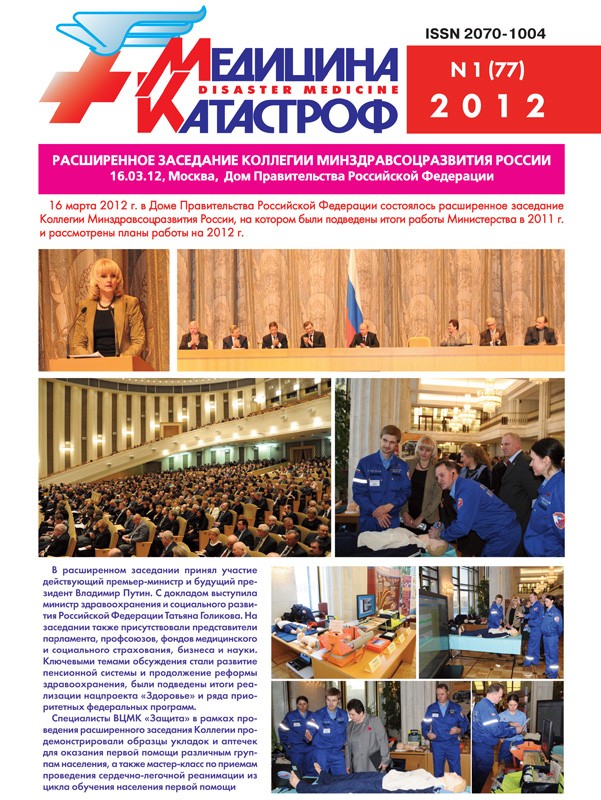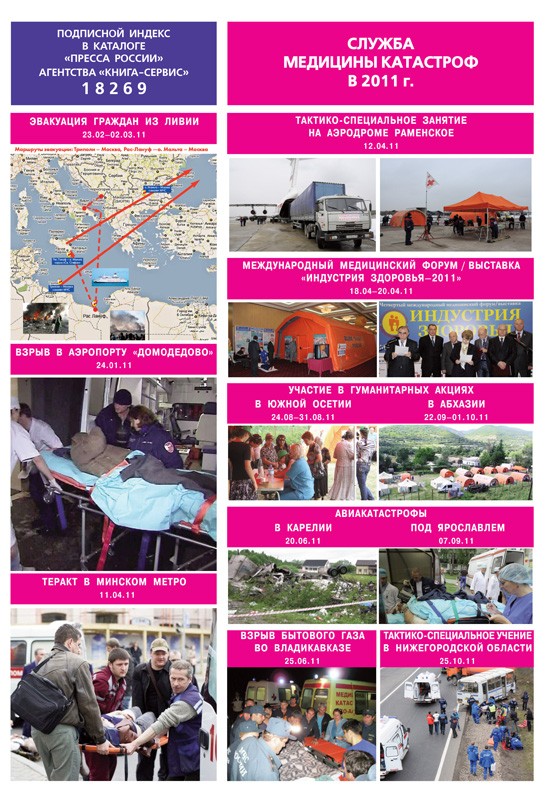ORGANIZATION AND TACTICS OF DISASTER MEDICINE SERVICE
1. Goncharov S.F., Bobiy B.V. Service for Disaster Medicine: The Main Results of its Activity in 2011 and its Tasks for the Nearest Future
The main results of activity of Service for Disaster Medicine (SDM) of Ministry of Health and Social Development of Russia in 2011 are discussed. A multifaceted complex of measures implemented by the Headquarters of All Russian Service for Disaster Medicine (ARSDM) and by Territorial Centers for Disaster Medicine (TCDM) in 2011 is presented. The main tasks facing SDM of Ministry of Health and Social Development of Russia in 2012 are defined.
Key words: casualties, emergency situations, Headquarters of All Russian Service for Disaster Medicine, medical and sanitary support, Service for Disaster Medicine of Ministry of Health and Social Development of Russia, Territorial Centers for Disaster Medicine
2. Sakhno I.I., Chernyak S.I. Preliminary Results of Realization by Service for Disaster Medicine of Regional Level of Russian Federation Government Resolution 660 of August 12, 2011
The first results are presented of realization of the Russian Federation Government Resolution 660 of August 12, 2011 by regional level Service for Disaster Medicine. The Resolution confirmed amendments in All Russian Service for Disaster Medicine Statutes. The most typical mistakes made in the process of realization of some of the items of the Resolution are analyzed.
Key words: All Russian Service for Disaster Medicine Statutes; Regional Level Service for Disaster Medicine; Russian Federation Government Resolution 660 of August 12, 2011; territorial centers for disaster medicine
3. Borisenko L.V., Akin’shin A.V., Ivashina L.I., Gavrilin V.N. Federal Reserve of Medical Goods and Medicinal Preparations for Care of Emergency Situations Victims: Principles of Reserves Formation
The principles of formation of Federal Reserve of medical goods and medicinal preparations for care of emergency situations victims are discussed. A detailed analysis is done of functioning of Field Multipurpose Hospital at the stages of formation and development of All Russian Service for Disaster Medicine. The main principle of reserve formation is laid down and the corresponding procedure and requirements are defined.
Key words: All Russian Service for Disaster Medicine, casualties, emergency situations, Federal Reserve of medical goods and medicinal preparations, Field Multipurpose Hospital
4. Yarmolich V.A., Bakanov M.Yu., Garmash O.A. Experience of Activity of Specialized Psychologic-Psychiatric Teams of Volgograd Oblast Territorial Center for Disaster Medicine in Fires of 2010–2011
The experience is presented of activity of specialized psychologic-psychiatric teams of Volgograd Oblast Territorial Center for Disaster Medicine in the fires of 2010-2011. It is noted that psychological care was most efficient in case of cooperation of psychiatrists and medical psychologists. The main principles of care of psychologically affected victims are discussed as well as the content of the “acute stress reaction” concept and other issues.
Key words: acute stress reaction, fires, psychological care, psychologically affected victims, specialized psychologic-psychiatric teams, Volgograd Oblast Territorial Center for Disaster Medicine
5. Burlutskaya A.V., Cherousov S.V. Elaboration of Unified Program “First Aid” is Challenge of Time
The issues of training of different contingents in first aid provision skills are discussed. A classification of the contingents and sample structure of a unified program “First Aid” are presented.
Key words: classification, trainee contingents, unified program “First Aid”
CLINICAL ASPECTS OF DISASTER MEDICINE
The structure of injuries in 441 patients with various pelvis traumas is studied. It is found that the most severe traumas were present in victims with multiple and concomitant injuries of pelvis bones and the main injury reasons were road traffic accidents.
Key words: concomitant injury, isolated injury, multiple injury, pelvis traumas, road traffic accident traumas, road traffic accidents, severity of injuries
7. Boyarintsev V.V., Nazarov V.B., Samoylov A.S., Chikin A.E., Kovalenko R.A., Dmitriev V.A. Temporary Hemostasis of Parenchymal Organs in Casualties with Polytrauma at Medical Evacuation Stage
The main stages of step-by-step surgical approach «damage control» as well as its pathogenetic rationale, introduction background and its present-day rendering are presented. A detailed description is given of hemostasis methods in severely injured with liver traumas at medical evacuation stage. Some data on experimental study of “Hemostop” efficiency in animal models with liver traumas and on clinical testing in casualties with severe injuries of parenchymal organs of abdominal cavity are given.
Key words: casualties, hemorrhage, hemostyptic “Hemostop”, liver trauma, medical evacuation stages, parenchymal organs, polytrauma, surgical approach «damage control»
8. Zakrevsky Yu.N., Manuylov V.M., Matveev R.P. Organization of Search and Rescue Operations and Treatment and Evacuation Measures in Maritime Catastrophes. Report 1
The present-day system of organization of search and rescue at sea and its normative and legal base are discussed.
The structure of injuries in rescued as well as the structure of fatalities in major maritime catastrophes in 1976-2011 resulting from hull damages and shipwrecks as well as from fires and explosions aboard are studied. The organization of treatment and evacuation measures including medical care of casualties with various types of traumas at medical evacuation stages is shown.
Key words: casualties, health care delivery, maritime catastrophes, rescue, search, structure of injuries, treatment and evacuation measures
9. Kipor G.V., Kozlov E.V., Bessonov A.V., Zaitseva S.N. Approaches to Substantiation of Use of Computer Instrumental Psychophysiology for Testing People in Hazardous Occupations
The main approaches to substantiation of use of methods of testing and correction of interhemispheric functional asymmetry in people in hazardous occupations (rescuers, drivers etc.) are discussed. A characteristic is given of computer instrumental psychophysiology methods used for diagnostics of organism functional status in people in hazardous occupations.
Key words: computer instrumental psychophysiology, functional asymmetry, neuropsychological regulation mechanisms, people in hazardous occupations, quanta of professional activity
10. Voynovsky E.A., Kovalyov A.S., Voynovsky A.E., Pil’nikov S.A., Il’in, V.A.Menzul V.A., Barkalev M.A. Primary Limb Amputation in Victims with Mine-Blast Traumas
The results of treatment of 198 wounded with mine-blast traumas in the period 1995-2011 are presented. The casualties were divided into two groups according to the treatment tactics. The first group consisted of 98 wounded whose residual limbs after amputation were overcast with primary sutures. The surgical tactics of primary amputation of limbs was used with the second group of 100 patients. In the second group a number of organ-saving amputations at the lower leg level was up to 56.7% from 49.3%, the frequency of suppurative complications was cut to 54% from 75.3%, and the number of repeated truncation was 27.9% instead of 44.3%, with lethality cut to 7% from 12.2%. The hospital treatment duration was shortened by (10±2,1) bed-days.
Key words: amputation, limbs, mine-blast trauma, primary amputation, reamputation
11. Simonenko V.B., Sarmanaev S.Kh., Prostakishin G.P., Sarmanaev B.S. Modern Approaches to Emergency Medical Care Delivery to Victims of Aggressive Compounds
MEDICAL ASPECTS OF ROAD TRAFFIC SAFETY
12. Mitin I.N., Shcheblanov V.Yu. Assessment of Psychophysiological Characteristics of Professional Drivers – is One of Constituents of Securing of Accident-Free Professional Activity
The necessity of inclusion of psychophysiological methodics into system of medical examination of professional drivers of transport vehicles is substantiated. The assessment data of psychophysiological status of drivers of mechanical transport vehicles classified by accident incidence rate, age and professional categories of drivers are analyzed. The ways of enhancement of medical and sanitary support of road traffic safety by identification of accident prone drivers.
Key words: accident-free professional activity, mechanical transport vehicles, professional drivers, psychophysiological characteristics, road traffic safety
13. Kozlov E.V. Analysis of the Level of Preparation of Driving Schools Instructors in Psychophysiological Aspects of Driving
The shortcomings in training of driving schools instructors in psychophysiological aspects of driving are analyzed. The conclusion is drawn that driving schools instructors lack essential knowledge in psychophysiological aspects of driving that affect negatively the training process and its results that is driving skills and experience of trainees.
Key words: driving schools instructors, driver training quality, psychophysiological aspects of driving
SANITARY-ANTIEPIDEMIC (PREVENTION) MEASURES IN EMERGENCIES
14. Batrak N.I. Role of Service for Disaster Medicine of Ministry of Health and Social Development of Russia in Solving Problems of Prophylaxis and Liquidation of Consequences of Biological and Social Emergency Situations Caused by Pandemic Flu Strains of Group A and by other Respiratory Viruses
The nature of the main etiologic factors of biological and social emergency situations caused by pandemic flu strains and by other respiratory viruses is discussed. A critical analysis is made of the prognosis of development of epidemiological situation in Russia and the world in 2009-2011 provided by specialists of Russia and of the World Health Organization. The role of disaster medicine structures of Ministry of Health and Social Development of Russia is shown in realization of some preventive and antiepidemic measures in the process of liquidation of consequences of biological and social emergency situations of the type discussed.
Key words: antiepidemic measures, biological and social emergency situations, pandemic flu strains, preventive measures, respiratory viruses, service for disaster medicine
15. Goncharov S.F., Suranova T.G. System of Further Vocational Education of Doctors of Medical Prophylaxis Specialization in Sanitary and Antiepidemic Support of Population in Emergency Situations
The relevance of elaboration of a system of further vocational education in issues of sanitary and antiepidemic support of population in emergency situations is substantiated and the ways of perfection of professional preparation of doctors of medical prophylaxis specialization in functioning in emergency situations environment.
Key words: doctors of medical prophylaxis specialization, emergency situations, further vocational education, sanitary and antiepidemic support
ACTUAL PROBLEMS OF EMERGENCY CONSULTATIVE MEDICAL CARE PROVISION AND OF MEDICAL EVACUATION
16. Prokopieva M.I. Organization of Emergency Consultative Medical Care Provision and of Medical Evacuation in Republic of Sakha (Yakutia)
The activity is shown of the Territorial Center for Disaster Medicine of the Republic of Sakha (Yakutia) in organization of emergency consultative medical care provision and of medical evacuation. The dynamics of quantity and structure of sick calls as well as transportation means and other issues are discussed. It is noted that in the last decade 91,8% of sick and emergency calls were attended with use of air transport.
Key words: air transport, emergency consultative medical care, medical aviation, medical evacuation, Republic of Sakha (Yakutia), Republican Center for Disaster Medicine, sick calls
SHORT REPORTS
17. Khovalyg D.A., Danzhalov V.V. Organization of Emergency Medical Care Delivery at Prehospital Stage to Victims of Road Traffic Accidents in Republic of Tyva
Organization of emergency medical care delivery at prehospital stage to victims of road traffic accidents in the Republic of Tyva. The analysis is done of the data on number of road traffic accidents, number of fatalities and wounded, the structure of injuries etc. It is stressed that the lethality rates in road traffic accidents in Tyva tend to grow and are among the highest in Russia. A system of stage-by-stage medical care delivery to road traffic accident victims is presented and some proposals on betterment of on the spot medical care delivery are made.
Key words: casualties, emergency medical care, medical evacuation stages, prehospital stage, Republic of Tyva, road traffic accidents
18. Peshkun A.V., Ehrtukhanov M.-Sh.S, Goncharov N.G., Midbreit I.M. Organizational aspects of emergency medical care delivery at prehospital stage to road traffic accident victims
Organizational aspects are discussed of emergency medical care delivery at prehospital stage to road traffic accident victims. A conclusion is drawn on the necessity of more profound study of the problem and of differentiating of the data received according to profiles of ambulance teams.
Key words: ambulance teams, emergency medical care, prehospital stage, road traffic accidents, victims

